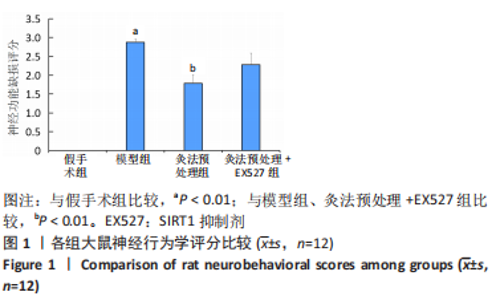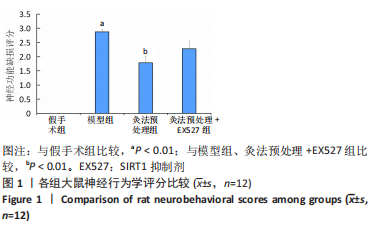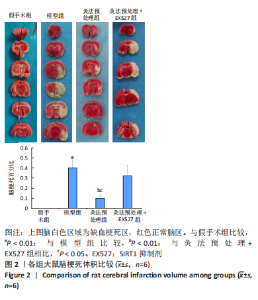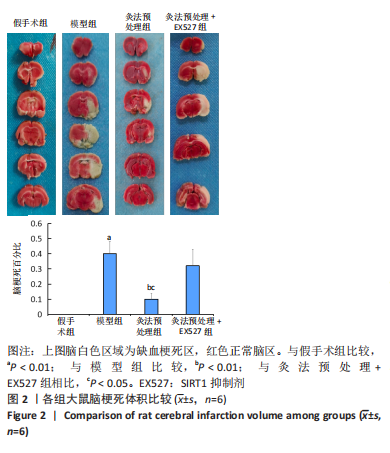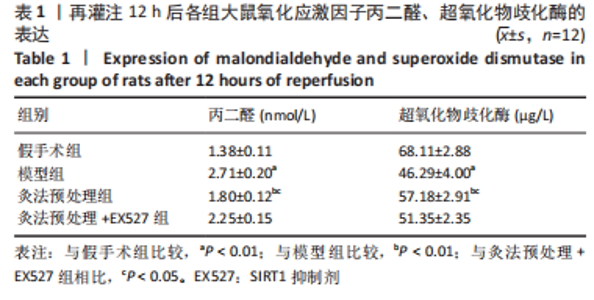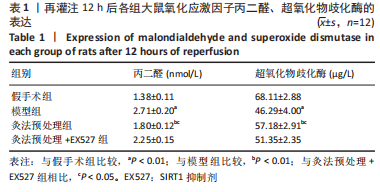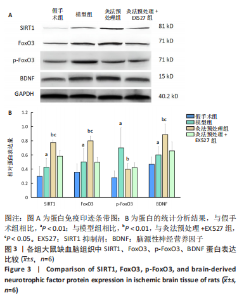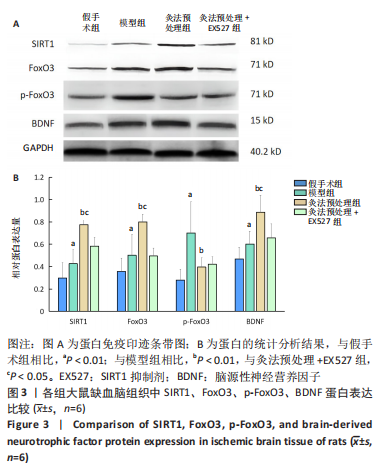[1] TIAN H, ZHAO Y, DU C, et al. Expression of mir-210, mir-137, and mir-153 in patients with acute cerebral infarction. BioMed Research International. Biomed Res Int. 2021;2021:4464945.
[2] HE J, XUAN X, JIANG M, et al. Long non-coding rna snhg1 relieves microglia activation by downregulating mir-329-3p expression in anin vitromodel of cerebral infarction. Experimental and Therapeutic Medicine. Exp Ther Med. 2021;22(4):1148.
[3] ZHANG X, ZHOU G. mir-199a-5p inhibition protects cognitive function of ischemic stroke rats by akt signaling pathway. American Journal of Translational Research. Am J Transl Res. 2020;12(10):6549-6558.
[4] WU X, ZHANG X, LI D, et al. Plasma level of mir-99b may serve as potential diagnostic and short-term prognostic markers in patients with acute cerebral infarction. J Clin Lab Anal. 2020;34:e23093.
[5] WEI YX, ZHAO X, ZHANG BC. Synergistic effect of moxibustion and rehabilitation training in functional recovery of post-stroke spastic hemiplegia. Complement Ther Med. 2016,26:55-60.
[6] 林子涵,阮传亮,周文强,等.辰时腹部艾灸治疗中风后下肢痉挛及对肌肉结构参数的影响[J].中国针灸,2020,40(10):1042-1046.
[7] 陈澄澄,宁松毅,杨静,等.艾灸预处理在癌症患者化疗后骨髓抑制中的应用[J].中华现代护理杂志,2021,27(1):38-43.
[8] 金洵,吕兴,韦艳会,等.不同时间艾灸预处理对卵巢储备功能减退大鼠卵巢功能的影响[J].针刺研究,2019,44(11):817-821.
[9] 蒋洁,赵百孝,陈立彬,等.灸法预处理脑缺血再灌注模型大鼠自噬及NLRP3炎症小体的表达[J].中国组织工程研究,2022,26(23): 3615-3619.
[10] LONGA EZ, WEINSTEIN PR, CARLSON S, et al. Reversible middlece- rebral artery occlusion without craniectomy in rats. Stroke.1989;20(1): 84-91.
[11] 李忠仁. 实验针灸学[M].北京:中国中医药出版社,2003:316.
[12] VIRANI SS, ALONSO A, APARICIO HJ, et al. American Heart Association Council on Epidemiology and Prevention Statistics Committee and Stroke Statistics Subcommittee. Heart Disease and Stroke Statistics-2021 Update: A Report From the American Heart Association. Circulation. 2021;143(8):e254-e743.
[13] FESKE SK. Ischemic Stroke. Am J Med. 2021;134(12):1457-1464.
[14] MENDELSON SJ, PRABHAKARAN S. Diagnosis and Management of Transient Ischemic Attack and Acute Ischemic Stroke: A Review. JAMA. 2021;325(11):1088-1098.
[15] HOLLIST M, MORGAN L, CABATBAT R,et al. Acute Stroke Management: Overview and Recent Updates. Aging Dis. 2021;12(4):1000-1009.
[16] JAYARAJ RL, AZIMULLAH S, BEIRAM R, et a. Neuroinflammation: friend and foe for ischemic stroke. J Neuroinflammation. 2019;16(1):142.
[17] ORELLANA-URZÚA S, ROJAS I, LÍBANO L, et al. Pathophysiology of Ischemic Stroke: Role of Oxidative Stress. Curr Pharm Des. 2020; 26(34):4246-4260.
[18] UZDENSKY AB. Apoptosis regulation in the penumbra after ischemic stroke: expression of pro- and antiapoptotic proteins. Apoptosis. 2019; 24(9-10):687-702.
[19] AMANTEA D,BAGETTA G.Excitatory and inhibitory amino acid neurotransmitters in stroke: from neurotoxicity to ischemic tolerance. Curr Opin Pharmacol. 2017;35:111-119.
[20] 李晓泓.针灸“治未病”与“针灸良性预应激假说”[J]. 北京中医药大学学报,2003,26(3):82-85.
[21] 周哲屹. 瑶医神火灸对缺血再灌注大鼠神经保护作用和机制研究[D].广州:广州中医药大学,2019.
[22] XIONG XY, WANG J, QIAN ZM, et al.Iron and intracerebral hemorrhage: from mechanism to translation. Transl Stroke Res. 2014;5(4):429-441.
[23] MA YH, DENG WJ, LUO ZY, et al. Inhibition of microRNA-29b suppresses oxidative stress and reduces apoptosis in ischemic stroke. Neural Regen Res. 2022;17(2):433-439.
[24] WAN J, REN H, WANG J.Iron toxicity, lipid peroxidation and ferroptosis after intracerebral haemorrhage. Stroke Vasc Neurol. 2019;4(2):93-95.
[25] NIIZUMA K, YOSHIOKA H, CHEN H, et al. Mitochondrial and apoptotic neuronal death signaling pathways in cerebral ischemia. Biochim Biophys Acta. 2010;1802(1):92-99.
[26] ZHANG XS, LU Y, LI W, et al. Cerebroprotection by dioscin after experimental subarachnoid haemorrhage via inhibiting NLRP3 inflammasome through SIRT1-dependent pathway. Br J Pharmacol. 2021;178(18):3648-3666.
[27] MAO H, WANG L, XIONG Y, et al. Fucoxanthin Attenuates Oxidative Damage by Activating the Sirt1/Nrf2/HO-1 Signaling Pathway to Protect the Kidney from Ischemia-Reperfusion Injury. Oxid Med Cell Longev. 2022;2022:7444430.
[28] YANG Y, DUAN W, LI Y, et al. New role of silent information regulator 1 in cerebral ischemia. Neurobiol Aging. 2013;34(12):2879-2888.
[29] ACCILI D, ARDEN KC.FoxOs at the crossroads of cellular metabolism, differentiation, and transformation. Cell. 2004;117(4):421-426.
[30] MANGIA A, SAPONARO C, VAGHEGGINI A, et al. Should tumor infiltrating lymphocytes, androgen receptor, and FOXA1 expression predict the clinical outcome in triple negative breast cancer patients?. Cancers. 2019;11(9):1393.
[31] BRUNET A, SWEENEY LB, STURGILL JF, et al. Stress-dependent regulation of FOXO transcription factors by the SIRT1 deacetylase. Science. 2004;303(5666):2011-2015.
[32] GILLEY J, COFFER PJ, HAM J. FOXO transcription factors directly activate bim gene expression and promote apoptosis in sympathetic neurons. J Cell Biol. 2003;162(4):613-622.
[33] WU Y, HUANG Y, CAI J, et al. LncRNA SNHG12 improves cerebral ischemic-reperfusion injury by activating SIRT1/FOXO3a pathway through I nhibition of autophagy and oxidative stress. Curr Neurovasc Res. 2020;17(4):394-401.
[34] DUAN J, CUI J, ZHENG H, et al. Aralia taibaiensis protects against I/R-induced brain cell injury through the Akt/SIRT1/FOXO3a pathway. Oxid Med Cell Longev. 2019;2019:7609765. |
